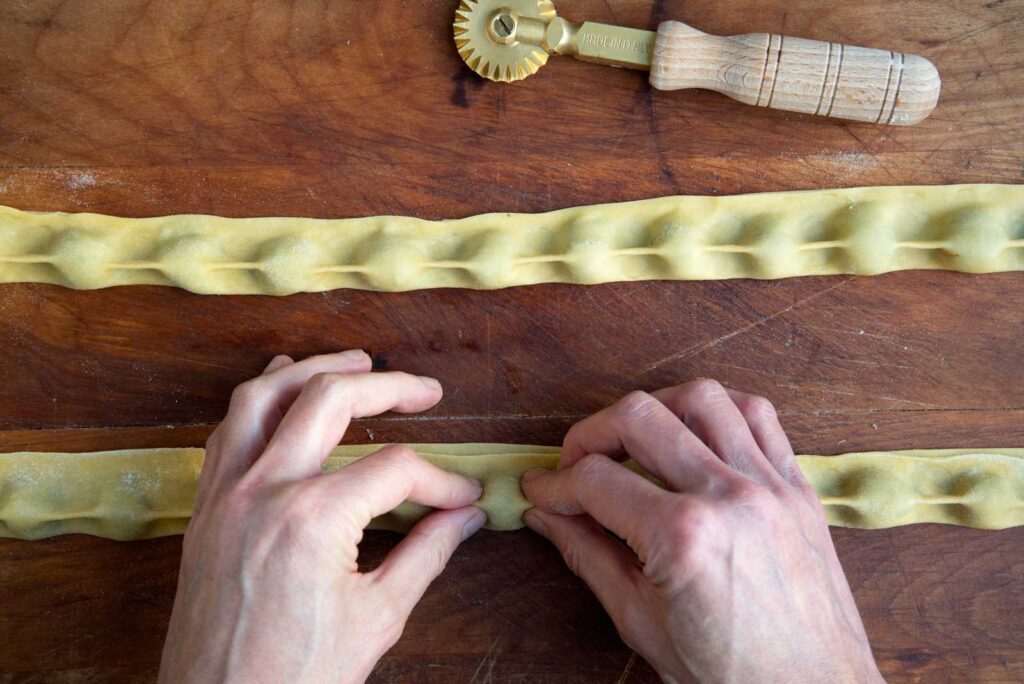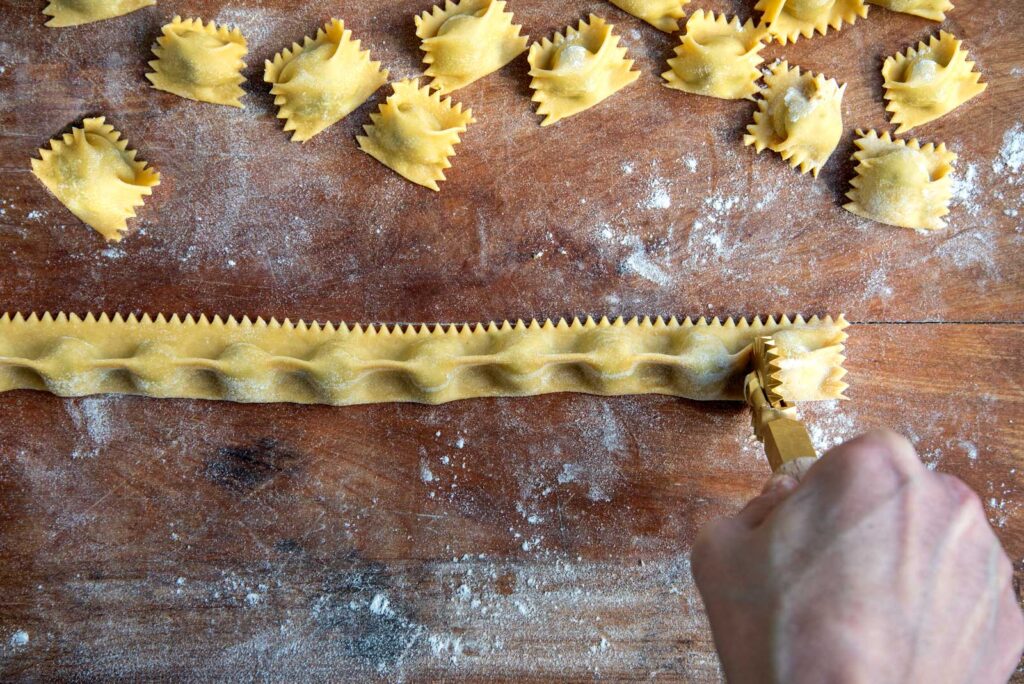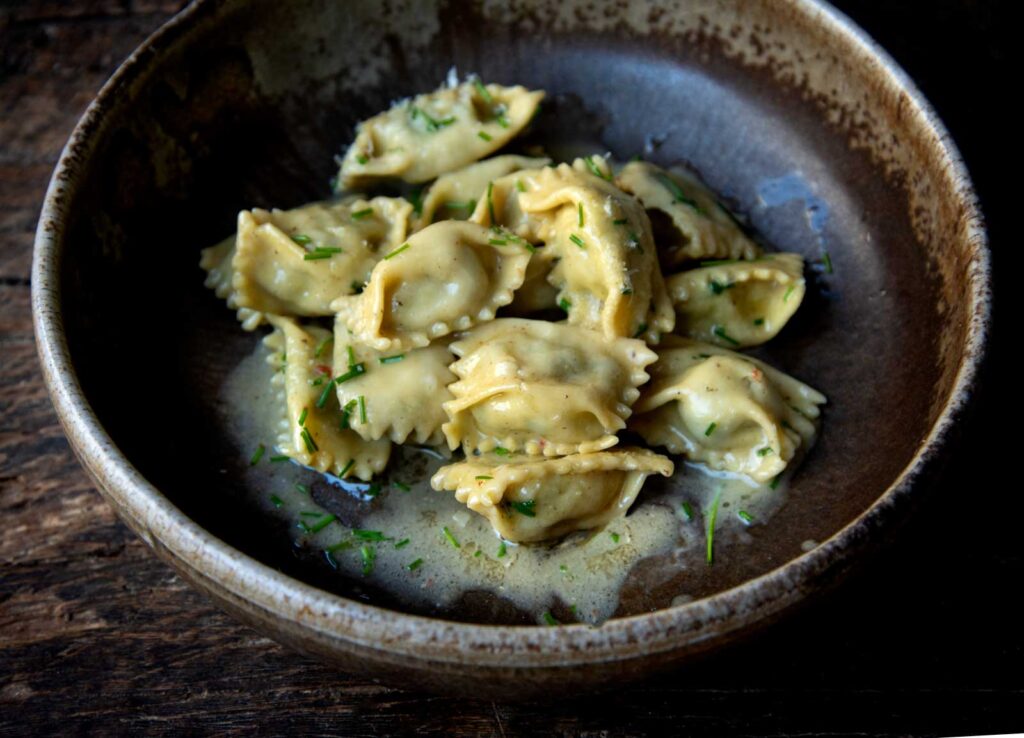Agnolotti (agnolotto singular) del plin are an iconic pasta from Piemonte in Northern Italy. Plin translates to pinch in the regional Piemonte dialect (pizzico in standard Italian) and refers to the way these pasta parcels are ‘pinched’ in order to give them their characteristic shape.
Meat filled agnolotti are typical – anything from beef, veal, lamb, rabbit, pork, and/or chicken, often a combination — and served simply in a sauce made from the braised meat. They may also be stuffed with local cheese and other seasonal vegetables.
I wanted to do a combination of meats, but since my local meat market only sells pre-packed, pre-weighed portions which was more than I needed, I decided to go with an all chicken filling. To make things a bit more interesting, I first smoked the whole chicken and then mixed it with spinach, Parmesan and a handful of of other ingredients.
Kept the sauce simple — made a stock from the leftover smoked chicken carcass; then emulsified the stock with some butter and finished the dish with some fresh spring chives that just popped up in my garden.
The agnolotti are rather light and delicate and rustic all at the same time.




Agnolotti del Plin with Smoked Chicken and Spinach
Ingredients
- Agnolotti dough (recipe below)
- 9 ounces roasted (or smoked) chicken
- 2 tbsp olive oil
- 1 small white onion, chopped
- 1/2 cup red wine
- 2 cups loosely packed spinach, coarsley chopped
- 1/4 tsp sherry vinegar
- 1 egg
- 3/4 cup freshly grated Parmigiano-Reggiano
- 1 1/2 tsp grated nutmeg
- freshly ground black pepper to taste
- salt to taste
To Finish the Dish:
- 1 cup chicken stock
- 8 tbsp butter
- chives (or other fresh herbs for garnish)
Instructions
- I smoked the chicken at 250F for 2 1/2 to 3 hours, until an instant thermometer registered 165F when inserted into the thickest part of the thigh without touching bone. Alternatively, you can roast the chicken. I used primarily dark thigh meat for the filling.
- For the Filling: Heat a skillet over medium heat. Add the olive oil and the onion and cook until soft and translucent, about 5 to 7 minutes. Add the red wine and cook until the pan is almost dry, about 2 minutes. Add the spinach and cook until just wilted, about 1 minute. Remove the vegetables to a bowl and set aside until completely cool. Drain any liquid that accumulates.Combine the onion mixture with the chicken in a bowl of a food processor. Grind it to a smooth texture (or chop it as finely as you can by hand). Once the meat is ground, add the vinegar, egg, Parmigiano-Reggiano and nutmeg and season with black pepper and salt. Mix well.
- To form the agnolotti: Slice off a section of the dough, rewrapping the unused portion in plastic wrap to prevent it from drying out. Place the piece of dough on the work surface and, with a rolling pin, flatten it enough so that it will fit into the widest setting of your pasta machine. Begin rolling the dough through the machine, starting with the widest setting. Then decrease the thickness setting by one and repeat with each successive setting until the dough is thin, about 1/16th of an inch (I rolled to setting #6 with my KitchenAid attachment).Using a wheel cutter or knife, cut the sheet of dough in half lengthwise, forming two strips that are about 3 inches wide. Place teaspoon-sized pieces of filling in a row along the entire sheet of dough, leaving 1/2 inch between each. Take the edge of the dough closest to you and fold it over—away from you—to cover the filling.To form the individual agnolotti, take your thumb and index finger and pinch the dough between the lumps of filling. Once the pinch is created along the length of the dough, seal the dough by gently pressing and removing any air pockets in the front edge.Using a fluted cutter, trim the length of the dough, cutting as close as you can get to the filling without breaking the seal. For the final agnolotti-forming cuts, using a fluted cutter, quickly and with some force, cut them one by one directly in the middle of each “pinch.” The trademark pocket should form with the swipe. Place the agnolotti on a baking sheet sprinkled with semolina. Repeat until you run out of dough or filling.
- To Finish the dish: bring a pot of salted water to a boil. Drop the pasta in the boiling water. Meanwhile, in a sauté pan add the chicken stock and butter. Turn the heat to high and bring the mixture to a simmer. Once the pasta is cooked 80 percent through, until almost al dente, about 2 minutes, transfer to the sauté pan. Stirring constantly but gently so as not to break the agnolotti, finish cooking the pasta in the sauté pan. This should take about 3 minutes. Toward the end of cooking, swirl the pan vigorously to create an emulsion and keep the sauce from breaking. The sauce should coat the back of a spoon.To serve, divide the pasta and sauce between 4 plates. Sprinkle with Parmigiano-Reggiano and fresh chives and serve immediately.
Notes
Agnolotti Dough
Ingredients
- 425 grams 00 flour
- 4 whole eggs
- 2 egg yolks
- 1 tsp olive oil
Instructions
- Place the flour on a dry, clean work surface and form it into a mound. Create a large shallow well in the middle, making sure the walls are high enough to prevent the eggs from escaping. Add the eggs, yolks and olive oil to the well.
- With a fork, beat the eggs; be careful not to disturb the walls of the flour. Once the eggs are well beaten, begin to incorporate the flour walls into the egg mixture. Continue incorporating the flour with the eggs with your fork until you have a shaggy, solid mass.
- At this point, using your hands, start folding and forming the dough, incorporating the rest of the flour until you have a stiff, solid mass (removing any dry clumps of flour). Knead the dough. Drive the palms of your hand into the dough, pushing the dough forward. Continue, rotating the dough and folding the dough over its self, which helps to incorporate air pockets into the dough. Repeat until the dough is firm and bouncy and has a smooth, silken texture, about 10 minutes.
- Wrap the dough in plastic and let rest 30 minutes.

